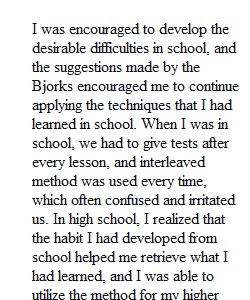


Q Application paragraph (Paragraph #2) • The topic sentence tells the reader what the rest of the paragraph will be about and should include 2 topics: o Topic #1: Your reaction to, or thoughts about, the “desirable difficulties” learning research the Bjorks discuss in their talk. o Topic #2: How might your approach to learning change in light of the “desirable difficulties” research? • The body of the paragraph should include: o 2 Claims: What’s a claim? A claim is a sentence the audience can reasonably disagree with and that introduces evidence. o Claim #1 will be about your reaction to the Bjorks’ conclusions about the role of “desirable difficulties” in learning. (Topic #1) ? Note: It’s up to you to narrow the focus of this claim enough to be able to successfully support it in just ½ a paragraph. You won’t be able to include all of your thoughts. Just pick one topic. For instance, does the research surprise you? Why? Were you ever taught a skill in the way the Bjorks suggest? Does that experience now make more sense? In other words, do you remember being frustrated during the practice sessions, but ultimately successful with that approach? Or have you been taught using the methods that make the practice sessions easier, but long-term retention more difficult? These are just two examples. You can take this claim in whatever direction you prefer, as long as it’s narrow enough to be covered successfully in ½ a paragraph. o Claim #2 will be about how your approach to learning new information and acquiring new skills might change now that you are aware of the “desirable difficulties” research. (Topic #2) ? When providing support for this claim, you’ll need to explain how the proposed change(s) reflect(s) the research covered in the talk. For instance, how what you are proposing is a type of interleaving and why that’s important for long-term retention. o A minimum of 2 pieces of evidence after each claim ? What’s evidence? Evidence is data, examples, and/or expert opinion that support(s) the claim. Here, the evidence is likely to come from your thoughts and experience. See the examples I listed under each claim topic above. o Sufficient explanation to make the claims and supporting evidence persuasive ? What’s explanation? Explanation provides any necessary context for understanding how the claims and evidence work together to create a persuasive argument. o Links/Transitions between one sentence and the next (and one idea and the next) o Concluding sentence(s) About the conclusion: The conclusion is not a separate paragraph. It is a few sentences at the end of your second paragraph. Use the conclusion to expand your focus from your own thoughts about and possible plans to incorporate “desirable difficulties” into your learning process to how these ideas might be applied more widely. Should anything about our schooling change?
View Related Questions